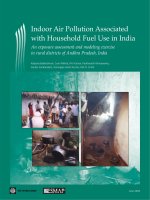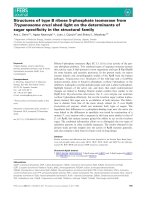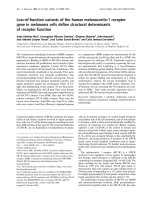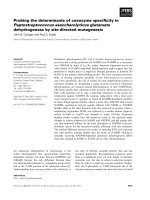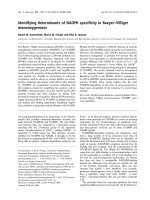Determinants of milk producers participation in marketing channels in Prakasam district of Andhra Pradesh State, India
Bạn đang xem bản rút gọn của tài liệu. Xem và tải ngay bản đầy đủ của tài liệu tại đây (168.04 KB, 5 trang )
Int.J.Curr.Microbiol.App.Sci (2019) 8(5): 1834-1838
International Journal of Current Microbiology and Applied Sciences
ISSN: 2319-7706 Volume 8 Number 05 (2019)
Journal homepage:
Original Research Article
/>
Determinants of Milk Producers Participation in Marketing Channels in
Prakasam District of Andhra Pradesh State, India
K. Vykhaneswari* and K. Uma Devi
Department of Agricultural Economics, Agricultural College, Bapatla, Acharya N.G. Ranga
Agricultural University, Andhra Pradesh, India
*Corresponding author
ABSTRACT
Keywords
Marketing channels,
Co-operative, Noncooperative,
Training facilities,
Multinomial logistic
regression model
Article Info
Accepted:
15 April 2019
Available Online:
10 May 2019
Milk production is the most important agricultural activity in the Indian
agricultural sector. India has achieved tremendous growth in milk
production during the last three decades. The study was undertaken with the
objective of factors influencing dairy farmers to choose the particular milk
marketing channel. A study was conducted in Prakasam district to identify
the factors influencing the dairy farmers. Data analysis using multinomial
logistic regression model revealed that average price of milk, distance to
the marketing channel and training facilities showed a significant impact on
type of channel chosen by the dairy farmer.
Introduction
From the chronic shortages of milk, India has
emerged as the largest milk producer in the
world crossing during the period 1950-51 to
2014-15, has increased from 17 Mt to 146.3
Mt ( Dairy activities
traditionally been integral to India’s rural
economy and have been emerging as one of
the fast growing sectors of the country.
Dairying has become an important secondary
source of income for millions of rural families
and has assumed the most important role in
providing employment and income generating
opportunities particularly for marginal and
women farmers. Prakasam (0.873 Mt) is the
highest milk producing district in A.P. But
more and more farmers are selling their old
infirm cattle in the market due to severe
fodder shortage in drought hit Prakasam
district during 2015-16. Cooperative and noncooperative dairies were involved in
marketing and distribution of milk and milk
products in Prakasam district. Since Indian
dairy industry, particularly the cooperative
sector, has a long and successful history of
linking smallholder milk producers with
markets. It is important to understand farmlevel impacts of changing dairy market
structures in India. It has also identified the
1834
Int.J.Curr.Microbiol.App.Sci (2019) 8(5): 1834-1838
factors that determine the growth and
development of livestock sector in the region.
This study is likely to help in developing
appropriate measures for enhancing the
growth of dairy sector in the region on a
sustainable basis.
Materials and Methods
The study was conducted in Prakasam district
which was purposively selected for the
research study as it is the highest milk
producing district in Andhra Pradesh with a
total milk production of 0.873 Mt during the
year 2014-15. Four mandals and two villages
from each mandal were selected purposively
based on their highest milk production
making a total of eight villages in the district
for sampling units. A total of 80 farmers from
each village were selected out of which, 20
farmers selling milk to cooperative society i.e.
Ongole dairy identified in the district and
remaining 60 farmers to non-cooperative
dairies which includes traditional, private and
milk collection centres were selected. Milk
collection centres are setup by a single farmer
where milk was collected from different dairy
farmers in the surrounding areas. The
information
on
the
socio-economic
characteristics of the respondents was
collected with the help of structured interview
schedule.
So, for analysing the factors influencing dairy
farmers to choose the cooperative and noncooperative channel, multinomial logistic
regression model was employed because this
model fits multiple discrete choice variables.
The econometric approach used is two-step
procedure with channel choice first and then
model the correlate behaviours with
endogenous stratification of the sample into
the channel strata, controlling for the
conditional probability of inclusion in a given
channel. In the sample selected, cooperative
dairy farmers did not sell raw milk in non-
cooperative channels and vice-versa. In noncooperative channels also, traditional
members did not sell raw milk to private and
MCC, private dairy farmers did not sell to
traditional and MCC channel and MCC
channel members did not sell to other
channels. The multinomial regression analysis
was done using STATA software. Multinomial
logistic regression is used to model nominal
outcome variables in which log odds of the
outcomes are modelled as a linear
combination of the predictor variables. The
first stage market channel choice is specified
as per equation (Greene, 2007. Econometric
Analysis).
Where,
Mij is a vector of the marketing choices (j = 0
for cooperative society, 1 for private dairy, 2
for MCC and 3 for traditional),
ᵦj is a vector of channel specific characteristics
and εij is the random-error estimation.
Xij is a vector of producer characteristics that
together influencing dairy farmer market
channel decision and the variables were given
as
M = Cooperative society (0), Private dairy
(1), MCC (2), Traditional (3)
X1 = Household size (≤ 3:0, 4-5:1, >5:2)
X2 = Milk Price (Rs. /lit)
X3 = Distance (km)
X4 = Production cost (Rs.)
X5 = Education (illiterate-0, literate-1)
X6 = Herd size (≤2:0, >2:1)
X7 = Experience-years (≤20:0, 21-25:1,
>25:2)
X8 = Training facilities (yes=1, no=0)
1835
Int.J.Curr.Microbiol.App.Sci (2019) 8(5): 1834-1838
The dependent variable (M) selected is a
multinomial type i.e. having more than two
sets which includes cooperative members and
non-cooperative members (traditional, private
and MCC dairy farmers).
Results and Discussion
The estimates of first-stage channel selection
results of multinomial logit coefficients and
marginal effects of market channel choice
were represented in table 2. While these
factors have facilitated access to market, their
effects are similar among different types of
milk producers. For comparing both
cooperative and non-cooperative channels,
cooperative market channel was chosen as the
base category and all the coefficients on that
channel were set to zero.
The multinomial logit regression analysis was
used to estimate the factors that influence
farmer’s choice of milk marketing channel.
Since coefficients are not directly interpreted,
marginal effects were also estimated to
express the probability of change in milk
marketing channel choices as a function of
each explanatory variable. From table 2, it can
be observed that selling price of milk per litre
showed positive significance in case of
private channel, milk collection centres and
traditional channel. The findings were similar
with Berem et al., (2015).
Average price of milk significantly
determined the probability of farmer
participation in private, MCC and traditional
where it had a positive effect (ME = 0.06 for
private, ME = 0.02 for MCC and ME = 0.04
for traditional channel). Average milk price
received by dairy farmers in traditional
channel was more i.e. Rs. 47.30 per litre
compared to others in non-cooperative and
cooperative channels, holding all other
variables in the model at their means.
Distance to their selected channel was
negatively related with MCC and traditional
channel participation, however it’s influence
was insignificant in case of private channel. It
could be observed that as distance increases,
farmers tend to shift to the nearby milk
markets. Similar findings were observed by
Sharma, 2009 concluded that distance is
negatively related with modern market
channel participation.
Distance
to
their
selected
channel
significantly determined the probability of
farmer participation in cooperative and noncooperative channel where it had a positive
and negative impact (ME = 0.11, ME = 0.02
and ME = 0.68 for private, MCC and
cooperative society respectively which
showed positive impact, where in one of the
non-cooperative channel it showed negative
impact i.e. ME = -0.18 for traditional
channel), holding all other variables in the
model at their means. With one kilometre
increase in distance the probability of a
farmer to choose the marketing channel was
11 %, 2 % and 68 % respectively.
Training facilities provided by the
government sector also influenced the farmers
to choose the particular marketing channel.
There has been a positive significant impact
in all the channels, but more in case of private
with less standard error followed by milk
collection centre and traditional channel. This
can be interpreted that the trainings attended
help the farmers to make a choice of better
marketing channel. Similar results were
confirmed in the study of Mutura et al.,
(2015) stated that there was a positive
relationship between choice own distribution
marketing channel and access to information
over marketing cooperatives.
Training facilities significantly determined
the probability of farmer participation in
cooperative and non-cooperative channels
1836
Int.J.Curr.Microbiol.App.Sci (2019) 8(5): 1834-1838
where it showed a positive impact i.e. ME =
0.18, 0.08, 0.27 and 0.30 for non-cooperative
channels which includes private, MCC and
traditional channel and cooperative channel
respectively, holding all other variables in the
model at their means. By providing training
facilities the probability of farmers to
participate in the training activities were 18
%, 8 %, 27 % and 30 % respectively (Table 1
and 2).
Table.1 Variables for the marketing channel choice model
Variable
Marketing channel choice
Average price
Distance to the preferred channel
Production cost
House hold size
Herd size
Education
Dairying experience
Training
Unit
Cooperative, Private, MCC
& Traditional
Rs./litre
Km
Rs./month
≤ 3:0, 4-5:1, > 5:2
≤2:0, >2:1
illiterate-0, literate-1
≤20:0, 21-25:1, >25:2
Yes- 1 and No- 0
Type of variable
Multinomial (0, 1, 2 and 3)
Continuous
Continuous
Continuous
Discrete
Discrete
Discrete
Discrete
Discrete
Table.2 Multinomial logit estimates and marginal effects of choice of milk marketing channel
Variable
Multinomial logit estimates
Private
MCC
Traditional
Marginal effects
Private
MCC
Traditi
onal
0.04
Ongole
dairy
-0.50
0.30 ⃰
0.45 ⃰
1.02 ⃰
0.06
0.02
(0.15)
(0.18)
(0.27)
0.17
-1.09 ⃰
-3.59 ⃰
0.11
0.02
-0.18
0.68
(0.33)
(0.42)
(1.20)
-0.03
0.01
0.00
-0.00
0.02
-0.00
-0.00
Production
(0.03)
(0.04)
(0.05)
cost (Rs.)
-0.22
0.70
1.66
-0.05
0.24
0.74
-0.04
House
hold
(0.65)
(0.75)
(1.04)
size
1.71
1.44
1.32
0.13
0.59
0.00
-0.19
Herd size
(1.33)
(1.20)
(1.44)
0.20
-0.25
-1.31
0.05
0.01
-0.07
0.00
Education
(0.79)
(0.87)
(1.35)
0.42
0.29
0.94
0.03
-0.23
0.04
-0.04
Dairying
(0.56)
(0.62)
(0.77)
experience
2.57 ⃰
2.32 ⃰
2.50 ⃰
0.18
0.08
0.27
0.30
Training
(0.97)
(1.01)
(1.31)
-14.85
-20.28
-43.40
Constant
2
2
2
N = 80, pseudo R = 0.4168, log likelihood = -64.677358, LR chi (24) = 92.45, Prob > chi = 0.000
Average price
(Rs.)
Distance (km)
Note: Co-operative society used as base category
⃰ denotes significance at 5% LOS
Figures in parentheses indicates standard error
1837
Int.J.Curr.Microbiol.App.Sci (2019) 8(5): 1834-1838
In conclusion, the traditional milk markets
being still dominant in India, policies that
engage with and improve these marketing
channels mainly in terms of milk quality and
safety, are likely to be most appropriate for
small scale milk producers, milk market
agents and consumers. Reducing transaction
costs (through institutions), improving milk
quality and safety through training and
extension programmes for dairy farmers and
improving milk marketing infrastructure are
critical for capacity building of smallholder
milk producers to compete in the market place
and with large-scale producers.
References
A.P. Socio-economic survey, 2014-15.
Berem, RM, Obare, G. and Bett, H. 2015.
Analysis of factors influencing choice
of milk marketing channels among
dairy value chain actors in peri-urban
areas of Nakuru country, Kenya.
European Journal of business and
Management. 7 (28): 174-179.
Department of animal husbandry, dairying
and fisheries – />Greene WH 2003. Econometric
Analysis. Prentice hall.
Hausman, J., and McFadden, D. 1984.
Specification tests for the multinomial
logit model. Econometrica. 52 (5):
1219-1240.
Mutura, JK., Nyairo, N., Mwangi, M. and
Wambugu, S.K. 2015. Analysis of
determinants of market channel choice
among smallholder dairy farmers in
Lower Central Kenya. International
Journal of Innovative Research &
Development. 4 (10): 264-270.
Sharma, VP., 2015. Determinants of small
milk producer’s participation in
organized dairy value chains: evidence
from India. Agricultural Economics
Research Review. 28 (2): 247-261.
Small, KA., and Hsiao, C. 1985. Multinomial
logit specification tests. International
Economic Review. 26 (3): 619-627.
How to cite this article:
Vykhaneswari, K. and Uma Devi, K. 2019. Determinants of Milk Producers Participation in
Marketing Channels in Prakasam District of Andhra Pradesh State, India.
Int.J.Curr.Microbiol.App.Sci. 8(05): 1834-1838. doi: />
1838





